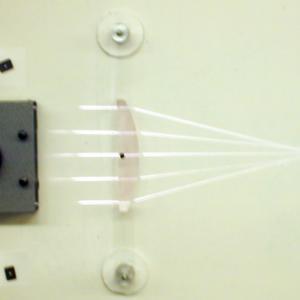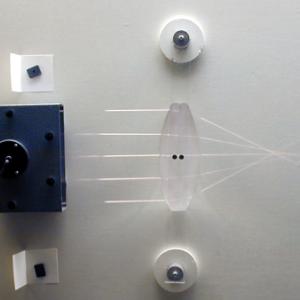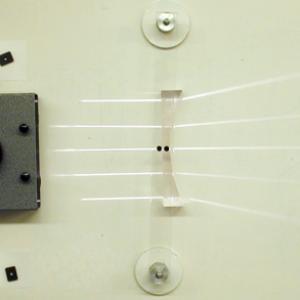College of Liberal Arts & Sciences
6A60.10 - Thin Lenses - Blackboard Optics
Video Credit: Jonathan M. Sullivan-Wood
Make sure the five rays coming out of the projector are parallel. Place a plano-convex or plano-concave lens with the middle ray going through the center of the lens. Accessories are available so that you can do a double convex or double concave lens if desired. The focal point may not be exact, but will be close enough for people to get the idea.
- Yu Jin, Hee Ra Kiim, Yu Chen, Ji Hyun Kim, Hyukjoon Choi, Jung Bog Kim, "Variable Focal Length lenses Made of Gelatin", TPT, Vol. 61, #6, Sept. 2023, p. 470.
- "Erratum: "Geometric Optical Experiments Using Water Mixed With Highlighter Ink", Phys. Teach. 60, 765-767", TPT, Vol. 61, #6, Sept. 2023, p. 427.
- Yu Chen, Hee Ra Kim, Yu Jin Ahn, Jung Bog Kim, "Geometric Optical Experiments Using Water Mixed with Highlighter Ink", TPT, Vol. 60, #9, Dec. 2022, p. 765.
- Shih-Hsin Ma, Jun-Yi Wu, Chun-Ming Chiang, "Drawing the Light Paths at a Lens to Find the Effective Focal Lengeh and Principal Planes", TPT, Vol. 60, #7, Oct. 2022, p. 591.
- Nuri Balta, "Gaussian Formula for Ray Tracing in Lenses and Mirrors", TPT, Vol. 60, #1, Jan. 2022, p. 56.
- Chris Chiaverina, "Gelatin Optics Revisited", TPT, Vol. 59, #5, May 2021, p. 380.
- Lasse Heikkinen, Antti Savinainen, and Markku Saarelainen, "Virtual Ray Tracing as a Conceptual Tool for Image Formation in Mirrors and Lenses", TPT, Vol. 54, #9, Dec. 2016, p. 538.
- Jeff Marx and Shabbir Mian, "Using Nonprinciple Rays to Form Images in Geometrical Optics", TPT, Vol. 53, #8, Nov. 2015, p. 497.
- Mickey Kutzner, "The Laser Level as an Optics Laboratory Tool", TPT, Vol. 51, #9, Dec. 2013, p. 532.
- Decha Suppapittayaporn, Bhinyo Panijpan, and Narumon Emarat, "Can We Trace Arbitrary Rays To Locate an Image Formed by a Thin Lens?", TPT, Vol. 48, #4, Apr. 2010, p. 256.
- Gene Mosca, "Alternative Presentation", TPT, Vol. 47, #6, Sept. 2009, p. 327.
- Paul Gluck and Benjamin Perkalskis, "Analog of Optical Elements for Sound Waves in Air", TPT, Vol. 47, #1, Jan. 2009, p. 75.
- Matthew Craig, Ryan Johnson, and Sara Schultz, "Steamy Optics: A System for Demonstrating Geometric and Physical Optics", TPT, Vol. 45, #4, Apr. 2007, p. 247.
- F. Logiurato, L. M. Gratton, and S. Oss, "Making Light Rays Visible in 3-D", TPT, Vol. 45, #1, Jan. 2007, p. 46.
- Edward P. Wyrembeck, "Modeling the Behavior of Light with a Light Cone", TPT, Vol. 44, #8, Nov. 2006, p. 549.
- Mario Branca and Isabella Soletta, "Construction of Optical Elements with Gelatin", TPT, Vol. 41, #4, Apr. 2003, p. 249.
- Ponn Maheswaranathan, "Revisiting Visualizing the Thin-Lens Formula", TPT, Vol. 39, #8, Nov. 2001, p. 452.
- Soumya Chakravarti and P.B. Siegel, "Visualizing the Thin-Lens Formula", TPT, Vol. 39, #6, Sept. 2001, p. 342.
- David L. Wagner and Thomas A. Walkiewicz, "When The Eye Meets The Lens", TPT, Vol. 38, #8, Nov. 2000, p. 474.
- Robert W. Lawrence, "Magnification Ratio and the Lens Equations", TPT, Vol. 38, #3, Mar. 2000, p. 170.
- Scott C. Dudley, "Trick of the Trade - How to Quickly Estimate the Focal Length of a Diverging Lens", TPT, Vol. 37, #2, Feb. 1999, p. 94.
- Joseph Ganem, "A Behavioral Demonstration of Fermat's Principle", TPT, Vol. 36, #2, Feb. 1998, p. 76.
- Patyick Bunton , "Edible Optics: Using Gelatin to Demonstrate Properties of Light", TPT, Vol. 35, #7, Oct. 1997, p. 421.
- Heidi Strahm Black, "More on Eating Optics", TPT, Vol. 36, #2, Feb. 1997, p. 67.
- W. Steve Quon, "Matrix Treatment of Ray Optics", TPT, Vol. 34, #6, Sept. 1996, p. 378.
- H. E. Siefken and H. E. Tomaschke, "Equipment for an Inexpensive Introductory Optics Lab", TPT, Vol. 32, #5, May 1994, p. 315.
- Ludwik Kowalski, "On Field Lenses", TPT, Vol. 30, #6, Sept. 1992, p. 366.
- R.H. Stinson, "A Biconvex Diverging Lens", TPT, Vol. 29, #9, Dec. 1991, p. 592.
- Harry D. Downing, Walter L. Trikosko, and Paula Lovell, "Ray Tracing for a Few $", TPT, Vol. 29, #6, June 1991, p. 369.
- Stuart Leinoff, "Ray Tracing with Virtual Objects", TPT, Vol. 29, #5, May 1991, p. 275.
- Roger E. Malcolm, "Fluid Lenses", TPT, Vol. 27, #8, Nov. 1989, p. 636.
- Se-yuen Mak, "A Simple Method to Determine the Refractive Index of Glass", TPT, Vol. 26, #8, Nov. 1988, p. 526.
- Robert Krohl, "A Convex Lens as a Thick Mirror", TPT, Vol. 26, #1, Jan, 1988, p. 18.
- John F. Koser, "A Laboratory Activity in Geometric Optics Using a 35-mm Single Lens Reflex Camera", TPT, Vol. 25, #7, Oct. 1987, p. 428.
- David Bardell, "The First Practical Application of Optical Magnification", TPT, Vol. 24, #4, Apr. 1986, p. 202.
- Ralph B. Knollenberg, "Ray Optics Corridor Demonstration", TPT, Vol. 19, #8, Nov. 1981, p. 563.
- J. Gerald Anderson, "A Practical Analysis of the Magnifying Glass", TPT, Vol. 19, #6, Sept. 1981, p. 417.
- Thomas B. Greenslade Jr. and Franklin Miller, Jr., "The Method of Curvatures", TPT, Vol. 19, #2, Feb. 1981, p. 88.
- Robert Gardner, "Ray Models of Concave Mirrors and Convex Lenses", TPT, Vol. 18, #8, Nov. 1980, p. 608.
- Pierre Lucie, "Thin Lenses Formulas", TPT, Vol. 16, #8, Nov. 1978, p. 555.
- Robert L. Siddon, "Simple Derivation of the Lens Maker's Equation", TPT, Vol. 16, #9, Dec. 1978, p. 647.
- Duncan T. Moore and Danette P. Ryan, "Gradient Index Optical Lenses", TPT, Vol. 15, #7, Oct. 1977, p. 409.
- George L. Hazelton and Larry Strooud, "Three Dimensional Ray Tracing", TPT, Vol. 10, #6, Sept. 1972, p. 344.
- Ian R. Gatland, "Thin Lens Ray Tracing", AJP, Vol. 70, #12, Dec. 2002, p. 1184.
- Og-7, 9, 10: Freier and Anderson, A Demonstration Handbook for Physics.
- O-310: "Blackboard Optics", DICK and RAE Physics Demo Notebook.
- George M. Hopkins, "Lenses", Experimental Science, p. 204.
- Pat Murphy, Ellen Macaulay, and the staff of the Exploratorium, "Lens Experiments", Exploratopia, p. 290.
- Roger E. Malcom, Edited by Karl Mamola, "Fluid Lenses", Apparatus for Teaching Physics, p. 222.
- Janice VanCleave, "Determine How the Focal Length of a Magnifying Lens Affects Its Magnifying Power", Super Science Challenges, p. 19.
- Raymond Bruman, "Optical Bench", Exploratorium Cookbook I, p. 12.1 - 12.3.
- Stangl, "Concave & Convex Lenses", Science Toolbox.
- C. Harvey Palmer, "Experiment A1: Thin Lenses and Thin Lens Combinations", Optics - Experiments and Demonstrations, John Hopkins Press, 1962.
- "Reflection and Refraction", Selective Experiments in Physics, CENCO, 1962.
- "Refraction Through a Single Thin Lens", Selective Experiments in Physics, CENCO, 1962.
- "Nodal Slide: A Study of the Properties of Thick Lenses", Selective Experiments in Physics, CENCO, 1962.
Disclaimer: These demonstrations are provided only for illustrative use by persons affiliated with The University of Iowa and only under the direction of a trained instructor or physicist. The University of Iowa is not responsible for demonstrations performed by those using their own equipment or who choose to use this reference material for their own purpose. The demonstrations included here are within the public domain and can be found in materials contained in libraries, bookstores, and through electronic sources. Performing all or any portion of any of these demonstrations, with or without revisions not depicted here entails inherent risks. These risks include, without limitation, bodily injury (and possibly death), including risks to health that may be temporary or permanent and that may exacerbate a pre-existing medical condition; and property loss or damage. Anyone performing any part of these demonstrations, even with revisions, knowingly and voluntarily assumes all risks associated with them.


